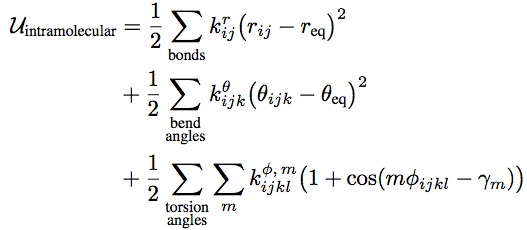Team:EPF-Lausanne/Theory
From 2009.igem.org
(Difference between revisions)
| Line 25: | Line 25: | ||
| - | + | To understand a bit more, you can see the following article: | |
[[Media:Introduction_to_molecular_Dynamics_Simulation.pdf | Introduction to Molecular Dynamics Simulation - Michael P. Allen]] | [[Media:Introduction_to_molecular_Dynamics_Simulation.pdf | Introduction to Molecular Dynamics Simulation - Michael P. Allen]] | ||
</div><div CLASS="epfl09bouchon"></div> | </div><div CLASS="epfl09bouchon"></div> | ||
Revision as of 18:57, 27 July 2009
Molecular dynamics simulation consists of the numerical, step-by-step, solution of the classical equations of motion. For this purpose we need to be able to calculate the forces acting on the atoms, and these are usually derived from a potential energy. This potential energy can be divided into:
- the non-bonded interactions:
- The Lennard-Jones potential is the most commonly used form, with two parameters: σ, the diameter, and ε, the well depth. It takes into account the Van der Waals forces. It represents the non-bonded forces and the total potential energy can be calculated from the sum of energy contributions between pairs of atoms.
- when electrostatic charges are present, we add the Coulomb force, where Q1, Q2 are the charges and ϵ0 is the permittivity of free space
- the bonded interactions: angles, bonds and dihedral angles have to be taken into account
To understand a bit more, you can see the following article:
Introduction to Molecular Dynamics Simulation - Michael P. Allen
 "
"



